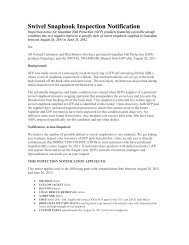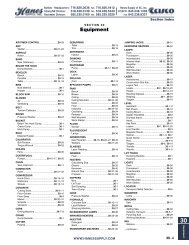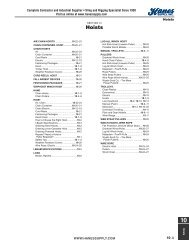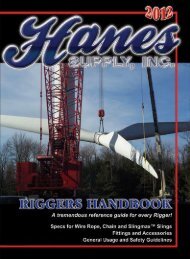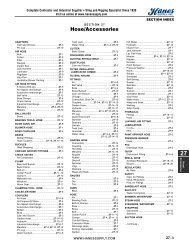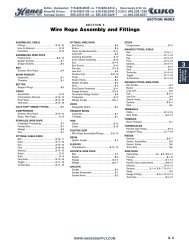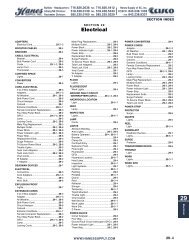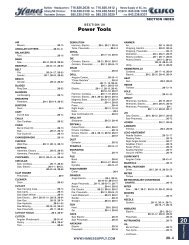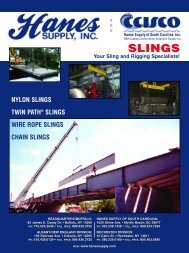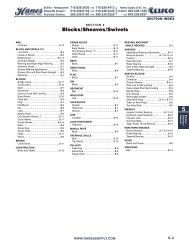Synthetic Slings - Hanes Supply, Inc
Synthetic Slings - Hanes Supply, Inc
Synthetic Slings - Hanes Supply, Inc
You also want an ePaper? Increase the reach of your titles
YUMPU automatically turns print PDFs into web optimized ePapers that Google loves.
Buffalo - Headquarters: 716.826.2636 FAX: 716.826.4412<br />
Albany/NE Division: 518.438.0139 FAX: 518.438.5343<br />
Rochester Division: 585.235.0160 FAX: 585.235.0229<br />
<strong>Hanes</strong> <strong>Supply</strong> of SC, <strong>Inc</strong>.<br />
CCISCO: 843.238.1338<br />
FAX: 843.238.8337<br />
Buffalo Web <strong>Slings</strong><br />
Important Facts About Buffalo Web <strong>Slings</strong> *Nylon & Polyester<br />
<strong>Synthetic</strong> <strong>Slings</strong><br />
How to Choose the Right Sling<br />
If you have any questions, please call <strong>Hanes</strong> <strong>Supply</strong>. Make sure you know<br />
the use, load and conditions for the sling you need. Reading the facts<br />
about web slings should help you decide.<br />
Nylon vs. Polyester<br />
Nylon Web - Strong & Economical<br />
Nylon is strong, lightweight and very flexible. It is highly resistant to alkalies,<br />
but should never be used in acid conditions. When treated for abrasion<br />
it has a stretch factor of 10%. Nylon can be worked in up to 200 O F.<br />
Polyester Web - Less Stretch & Acid Resistant<br />
Polyester webbing has become very valuable especially in applications<br />
which subject the sling to acid conditions. Also polyester slings are excellent<br />
where headroom is limited because of the webbing stretch characteristics.<br />
Polyester can worked in up to 200 O F.<br />
Sling Strength<br />
OSHA standards demand that the rated capacity be noted on each sling.<br />
Check the capacity tables in this catalog to make sure of the strength of<br />
the sling you may need. Do not ever exceed rated capacities of a web<br />
sling.<br />
Each Buffalo Web Sling has a leather tag which states the manufacturer,<br />
the type of material rated capacities, type of sling, and length and width<br />
of the sling.<br />
Each Buffalo Sling also has a warning tag about inspection and<br />
restrictions as to the web sling.<br />
Use of Sling<br />
1. Load surface problem<br />
If sharp or rough edges come in contact with web slings cutting or accelerated<br />
wear could occur. Certain accessories in this catalog could help protect<br />
the sling.<br />
2. Avoid Crushing and Knotting of <strong>Slings</strong><br />
Don't crush a sling between load and other surface.<br />
3. Do not expose the sling to the sun for an extended period of time.<br />
Prolonged exposure of sling to the sun will degrade lifting capacity.<br />
4. Different Hitches' Rated Capacities<br />
<strong>Slings</strong> have the largest load when used in the basket hitch. Capacity in the<br />
vertical hitch is 50% of that in the basket hitch. Capacity in the choker<br />
hitch is 40% of basket hitch capacity.<br />
Web Material - Soft & Flexible<br />
Web <strong>Slings</strong> are made from nylon or polyester lifting yarn that is woven into<br />
various widths and thicknesses. The lifting yarn is surrounded by a tough<br />
abrasive resistance jacket yarn.<br />
Red Warning Core<br />
Red colored yarns under the jacket show when the jacket is worn or cut<br />
through and indicate that the sling should be taken out of use.<br />
Shock Absorption<br />
The stretching of web slings allows a cushion against sudden shock.<br />
When loaded at rated capacity, a nylon sling will stretch 6-8% and<br />
polyester 3-4%. <strong>Slings</strong> return to normal length when not loaded.<br />
Red Core Yarns<br />
Warning System<br />
All <strong>Hanes</strong> <strong>Supply</strong> <strong>Inc</strong>., nylon and<br />
polyester web slings have red warning<br />
yarns. Red core yarns become exposed<br />
when the sing surface is cut or worn<br />
through the woven face yarns. This is<br />
one criteria, but not the only one<br />
for removal from service. For more<br />
information, see OSHA Requirements.<br />
Standard Sling Types<br />
Type 1 – TC <strong>Slings</strong>: <strong>Slings</strong> have a triangle fitting on<br />
one end & a slotted triangle fitting (the choker) on the<br />
other end. Choice of lightweight aluminum or durable<br />
steel fittings.This is most commonly used in a choker<br />
hitch, but can also be used in basket and vertical<br />
hitches.<br />
Type 2 – TT <strong>Slings</strong>: <strong>Slings</strong> have a triangle fitting on<br />
each end. Used in vertical and basket hitches only<br />
(basket hitch being most typical). Choice of lightweight<br />
aluminum or durable steel fittings.Type 2<br />
slings are more economical than Type 1.<br />
Type 3 – EE <strong>Slings</strong>: <strong>Slings</strong> have eyes at both ends–<br />
choice of straight or tapered eyes (tapered eyes are<br />
standard > 2" web-width). Flat Eye slings are very<br />
popular slings which can be used in all three types of<br />
hitches. They are easy to remove from beneath the<br />
load after the load is in place. Unless Type 4 is<br />
requested, Type 3 will be supplied as the standard<br />
EE sling.<br />
Type 4 – EE <strong>Slings</strong>: Twisted Eye slings are similar<br />
to Type 3 except the eyes are twisted to a 90 O right<br />
angle to the sling body to form a better choker hitch.<br />
This type of eye also nests together better when<br />
used in a basket hitch. (Tapered eye are standard ><br />
2" web-width)<br />
Type 5 – EN: - Endless slings, sometimes also<br />
referred to as grommet slings, are very economical .<br />
This is the most versatile sling. They can be used in<br />
all three types of hitches and wear points can be<br />
moved to increase sling life. The sling legs can be<br />
spread for improved load balance.<br />
Type 6 – RE: Return Eye Sling is also referred to as<br />
Reversed Eye Sling. Sling body is formed by 2 parts<br />
of webbing sewn side by side using either a cordura<br />
tube or web in the finished width creating a protective<br />
webbing over the entire body and eyes. This extra<br />
webbing reinforces the sling and protects it from<br />
wear, resulting in an exceptionally strong sling.<br />
Measuring Web <strong>Slings</strong><br />
With sling layed flat, measure Pull-to-Pull.<br />
Hitches<br />
Vertical Choker Basket<br />
Hitches<br />
Vertical Basket<br />
Hitches<br />
Vertical Choker Basket<br />
Hitches<br />
Vertical Choker Basket<br />
Hitches<br />
Vertical Choker Basket<br />
Hitches<br />
Vertical Choker Basket<br />
8<br />
<strong>Synthetic</strong><br />
<strong>Slings</strong><br />
Length<br />
Length<br />
Length<br />
WWW.HANESSUPPLY.COM<br />
8-1



